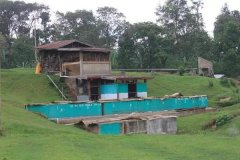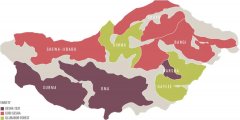Panamanian Poket boutique coffee details what is the quality of Panamanian Rosa coffee beans?
Although Panama has been growing coffee since the early 20th century, over the past 20 years, the country has been known only for producing high-quality coffee.
Today, thanks in large part to the success of the geisha breed, Panama is famous for producing high-quality coffee and is sought after by bakers, buyers and competing baristas around the world.

Panamanian area
As an equatorial country located in the soybean belt, Panama has an ideal climate for growing coffee plants. According to the United States Department of Agriculture, more than 80% of the coffee grown in Panama is Arabian coffee and the remaining 20% is robusta coffee.
Robusta mainly grows in low altitude areas, including Cocle,Panama Oeste, Colon ó n, Veraguas,Herrera,Los Santos,Bocas del Toro,Panama Este and Darien.
However, the high mountains of Chiriqu í province provide ideal conditions for Arabica plants. Perhaps the most famous mountain town, Boquete, is famous for its fine Arabica coffee, in part because it is between 1000 and 2800 masra above sea level.
Coffee grown in Chiriki is mainly exported, while Robusta coffee grown in the lowlands of Panama is mainly for local consumption.
The country consumes about 20 million kilograms of coffee a year, equivalent to about 5 kilograms per capita. This is relatively high in most producing countries, where per capita consumption is usually between 1 and 3 kg.
Chiriki, prov.
The mountainous highlands of Chiriqu í province provide an ideal elevation for the cultivation of Arabian plants. The three main coffee growing areas of Chiriqu í are Boquete,Tierras Altas and Renacimiento.
The province is also located along the Central American volcanic arc (CAVA), including Volc á n Bar ú, with a peak of 3474 Masra in the country.
Volc á n Bar ú is an active advection volcano, which last erupted in the 16th century. The eruption is believed to have occurred about 450 years ago and was sprinkled with Tephra on the surrounding soil. Therefore, today, the soil around the volcano is nutritious and fertile, making it very suitable for growing coffee.
The Chiriqu í region also benefits from the country's unique weather conditions. Panama has more than 100 "microclimates", which means that the weather often varies greatly from region to region.
What varieties are grown in Panama?
Panama's unique conditions enable manufacturers to grow many high-quality varieties, including Catuai, Caturra, Maragogype, Pacamara and Mundo Novo. Today, however, Panama is most relevant to one of the most important species: the geisha.
Although Panamanian coffee is related to geisha, the breed actually comes from Ethiopia and was grown in Panama only in the 1960s. The cup shape of Yi ish has good sweetness and bright acidity, usually with fruity and floral aromas.
FranciscoSerac í n is the owner of Don Pachi Estate. His family has been growing coffee in Panama for nearly 150 years. He told me that it was his father (also known as Francesco Serac í n, but renamed "Don Pachi") who first introduced the geisha breed to Panama.
Don Pachi is the founder of the Special Program of the Panamanian Ministry of Agricultural Development. Don Pachi also spent some time at the Center for Tropical Agricultural Research and higher Education (CATIE) in Costa Rica, where he received seeds from the ish variant and later brought it back to Panama. Then he distributed the seeds to other producers.
Today, Francisco told me that his father was "a very far-sighted man".
"he has the ability to see coffee as what it is today," he told me. "it's a unique, luxurious, high-quality product with a differentiated market."
"the accidental arrival of geisha varieties has been the vanguard of helping the development of the coffee industry in Panama.... Today, it has something to do with the quality of quality coffee. "

Panamanian specialty coffee association
Although the geisha species arrived in Panama in the 1960s, it was not until 1997 that the Panamanian Special Coffee Association (SCAP) was established.
The founding members of SCAP set out to grow coffee on their farms and refocus on quality rather than yield. These producers have also learned to cup and taste coffee, which in turn gives them more choices about the kinds of coffee they will grow.
In 1998, a year after the establishment of SCAP, the Panamanian Best Competition (BOP) was born. In 2001, BOP held its first international online auction, attracting buyers from all over the world to buy Panamanian coffee.
These auctions have given Panamanian coffee (and therefore Panama's origin) more exposure. At the time, producers thought the price of $2 per pound was successful.
Reach the turning point
Wilford Lamastus Jr. Is the fourth generation coffee producer of Lamastus Family Estates. He told me that thanks to Art Ge Coffee and BOP, the industry is growing exponentially year after year.
"at that time, prices went up because the quality of coffee raised the price of coffee and won the competition," Wilford said. " He points out that even if buyers are willing to pay a high price for coffee, there is no obvious difference. This is where geisha became popular.
Although many coffee producers bought a geisha from Don Pachi, Price and Hacienda La Esmeralda's Daniel Peterson were the first to sell it at record prices. On BOP 2004, geisha from Esme Hacienda La Esmerelda were sold at the historic price of $21 a pound at the time.
"[after that], the market began to think about variety," Wilford explained. "from that day on, when buyers realized that there was a unique and special variety, they began to emphasize the variety."
Three years later, in 2007, another Hacienda La Esmerelda coffee broke the triple-digit barrier and sold for $130. Hacienda La Esmerelda continued to break four other auction records over the next decade.
After 2017, however, it was Lamastus Family Estates who set the next two records. Their one-pound geisha sold for $803 in 2018 and broke the four-digit barrier at $1029 a pound in 2019.

The price record per pound has been broken every year since 2014. Although the Covid-19 pandemic means that BOP is completely virtual in 2020, it still managed to break the world record.
However, neither Lamastus Family Estates nor Hacienda La Esmerelda created the new price of BOP 2020. Instead, it was a new world record for coffee set by Finca Sophia's washed geisha, with an auction price of $1300.50 each.
Now, the record has been broken for six years in a row, which shows the amazing growth of Panamanian specialty coffee and the influence of art ish varieties.
Coffee Culture of Panamanian consumers
Before 2000, Panama consumed very little specialty coffee. However, since then, the increase in the number of professional coffee shops nationwide has reflected great changes in production.
AlbertoBerm ú dez is the founder and chief baker of Caf é Unido in Panama City. He told me that the cafe é Unido, which opened in 2014, aims to share these exclusive high-quality Panamanian coffees with consumers and connect them with producers.
Alberto says he believes broader changes have taken place from generation to generation. Young consumers are more willing to try coffee, while the older generation has a different idea of making coffee "good," he said.
"it's completely different," Alberto said. (Panamanian coffee) has floral, fruity and more stylish flavors, rather than the dark aromas of more traditional roasted coffee.
"there is an" obstacle "to specialty coffee. Unlike other luxuries, quality coffee is necessary to fully enjoy the experience."
He added that he believes the recent increase in the number of home-brewed winemakers in Panama is good for the wider industry. "when you make your own coffee, you will understand it better and appreciate it more," he said. "
Important Notice :
前街咖啡 FrontStreet Coffee has moved to new addredd:
FrontStreet Coffee Address: 315,Donghua East Road,GuangZhou
Tel:020 38364473
- Prev

Characteristics of altitude taste in Essex plus Sheffield Coffee producing area description of brewing flavor of coffee beans in Edido cooperative
Professional coffee knowledge exchange more coffee bean information please follow the coffee workshop (Wechat official account cafe_style) since the implementation of the Ethiopian commodity exchange (EXC) exchange system in 2008, most raw coffee beans have been sold through competitive bidding under this system, but cooperatives are not within this jurisdiction.
- Next

What is the difference between the flavor of rose summer coffee in Ethiopia and that in Panama?
Professional coffee knowledge exchange more coffee bean information Please follow the coffee workshop (Wechat official account cafe_style) Rose Summer Coffee is well-known. In addition to Panama, Rose Summer Coffee is also grown in Costa Rica, Colombia and other countries, including the famous Rosa Village manor in Ethiopia. In the front street, through a cup of rosy summer coffee from the village and the well-known Bana.
Related
- Beginners will see the "Coffee pull flower" guide!
- What is the difference between ice blog purified milk and ordinary milk coffee?
- Why is the Philippines the largest producer of crops in Liberia?
- For coffee extraction, should the fine powder be retained?
- How does extracted espresso fill pressed powder? How much strength does it take to press the powder?
- How to make jasmine cold extract coffee? Is the jasmine + latte good?
- Will this little toy really make the coffee taste better? How does Lily Drip affect coffee extraction?
- Will the action of slapping the filter cup also affect coffee extraction?
- What's the difference between powder-to-water ratio and powder-to-liquid ratio?
- What is the Ethiopian local species? What does it have to do with Heirloom native species?

